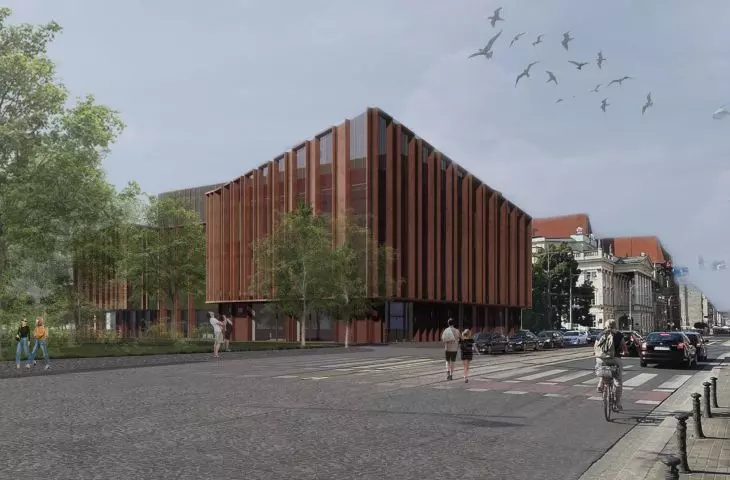Magdalena Strauchmann and Anna Wancel of Wrocław University of Technology, as part of a design assignment at the Faculty of Architecture, proposed Spaces of Sound, a museum dedicated to sound, which they placed in the very center of Wrocław. Located adjacent to the Wrocław Opera House, the new building offers a unique experience of sound, from interactive experimental spaces, educational rooms to an intimate concert hall.
The project was developed during the course Architectural Design—Public Utility Buildings, under the direction of Dr. Elżbieta Komarzyńska-Swieściak during the first semester of the second degree program. Part of the assignment was also to „set up” their own studio and come up with a name for it. Magdalena Strauchmann and Anna Wancel formed the duo 2PACK as part of the challenge and designed the sound museum in Wrocław.
sound museum, facade from the side of the City Moat
© Magdalena Strauchmann, Anna Wancel
experience of sound
This is a place where sound is perceived in a tangible and intangible way. The overriding value in the design process was the idea of complementation. The existing urban context—the frontage of Świdnicka Street, the Wrocław Opera House, the National Forum of Music or the City Moat—meant that our building could become a complement not only in the urban sense, but also to the neighboring functions," the students explain the idea.
sound museum, diagram, location on the map of Wrocław
© Magdalena Strauchmann, Anna Wancel
The authors wanted to relate the new development to the front elevation of the Wrocław Opera House, additionally it became important for them to emphasize the corner—a height accent. The slant, they claim, refers to the slanted roofs of the surrounding historic buildings. On the other hand, the introduction of a semi-open courtyard on the side of the Moat gives lightness to the mass and allows for the organization of intimate audiences.
museum of sound, first floor plan
© Magdalena Strauchmann, Anna Wancel
educational halls
The first floor is a public space, with a temporary exhibition and a restaurant. In addition, there is a listening room—the sound library. The exhibition halls have been designed in a way that facilitates intuitive movement. The first is the natural room, where users can experience traditional pure sound reflection. The next is a sound-absorbing space. The room has been finished with special sound attenuating materials. This allows viewers to notice a significant difference between one room and another.
sound museum, cross-section A-A
© Magdalena Strauchmann, Anna Wancel
The next experience is a distraction. The irregular finish of the walls and the ceiling, above which the concert hall is located, allows visitors to notice the phenomenon of scattering sound waves. In addition, from the room exploring scattering, users can move to the multimedia room. The space is flexible and can change functions, once being a listening room and at other times an educational room.
view from the moat and the division of the educational rooms
© Magdalena Strauchmann, Anna Wancel
sensory-experimental rooms
After learning about the three phenomena concerning sound, visitors will also have the opportunity to study the propagation of sound waves along the obtuse forms. To this end, students have designed irregular walls and tubes of varying diameters and finishing materials. Another of the rooms also tests the way sound is perceived, with helmets of various sizes and workmanship hanging from the ceiling to help. The sensory-experimental room is the culmination of the first part of the exhibition.
We have also provided for an optional room to be explored—one that studies the effect of sound on humans while controlling the intensity of light, the type of light, or even the absence of light. The inspiration for creating such an extreme room came from the problem of loss of sight and its effect on the perception of sound, the authors explain.
interior of the museum
© Magdalena Strauchmann, Anna Wancel
In turn, sound is explored in a space with moving ceilings—some of which are freely lowered and raised. In this way, the students alluded to the suspended ceilings used in concert halls. The next room has movable screens of different materials and with speakers designed inside. Museum visitors can move the panels according to their own invention and generate individual sounds. The penultimate room is periscopes. Piercing the ceiling, the devices allow visitors to hear the bustle of the café below. The final experience is an anechoic chamber. In addition to the exhibition halls, the designers also placed an intimate concert hall in the building in an auditorium layout.
museum of sound on Świdnicka street in Wrocław
© Magdalena Strauchmann, Anna Wancel
When developing the task, the students also took into account ecological assumptions. Thus, the wall opening to the greenery was designed to allow water retention in the form of closed-circuit sound water falls. The authors also proposed green roofs, serving as terraces on which to hold summer concerts.









































